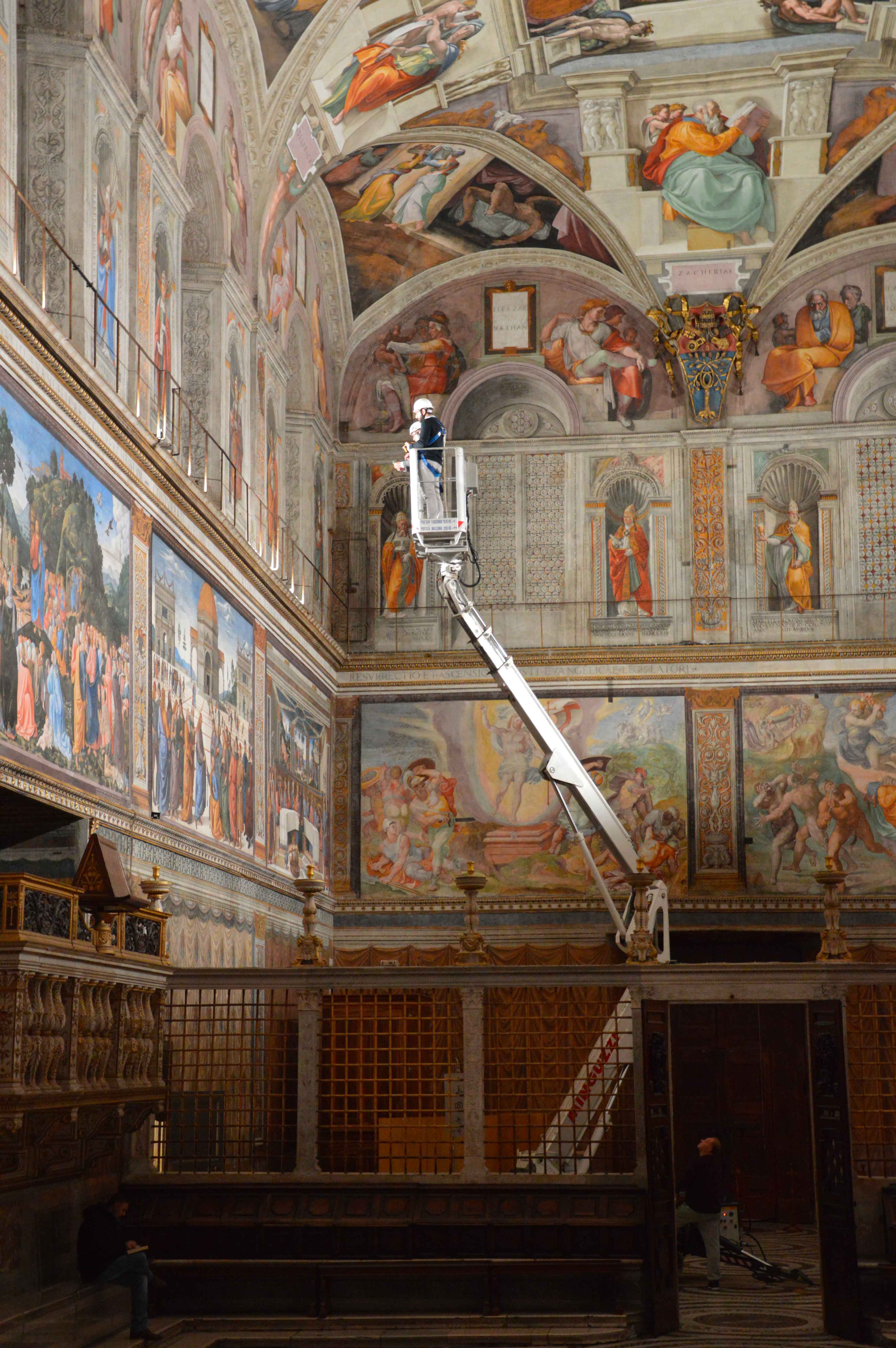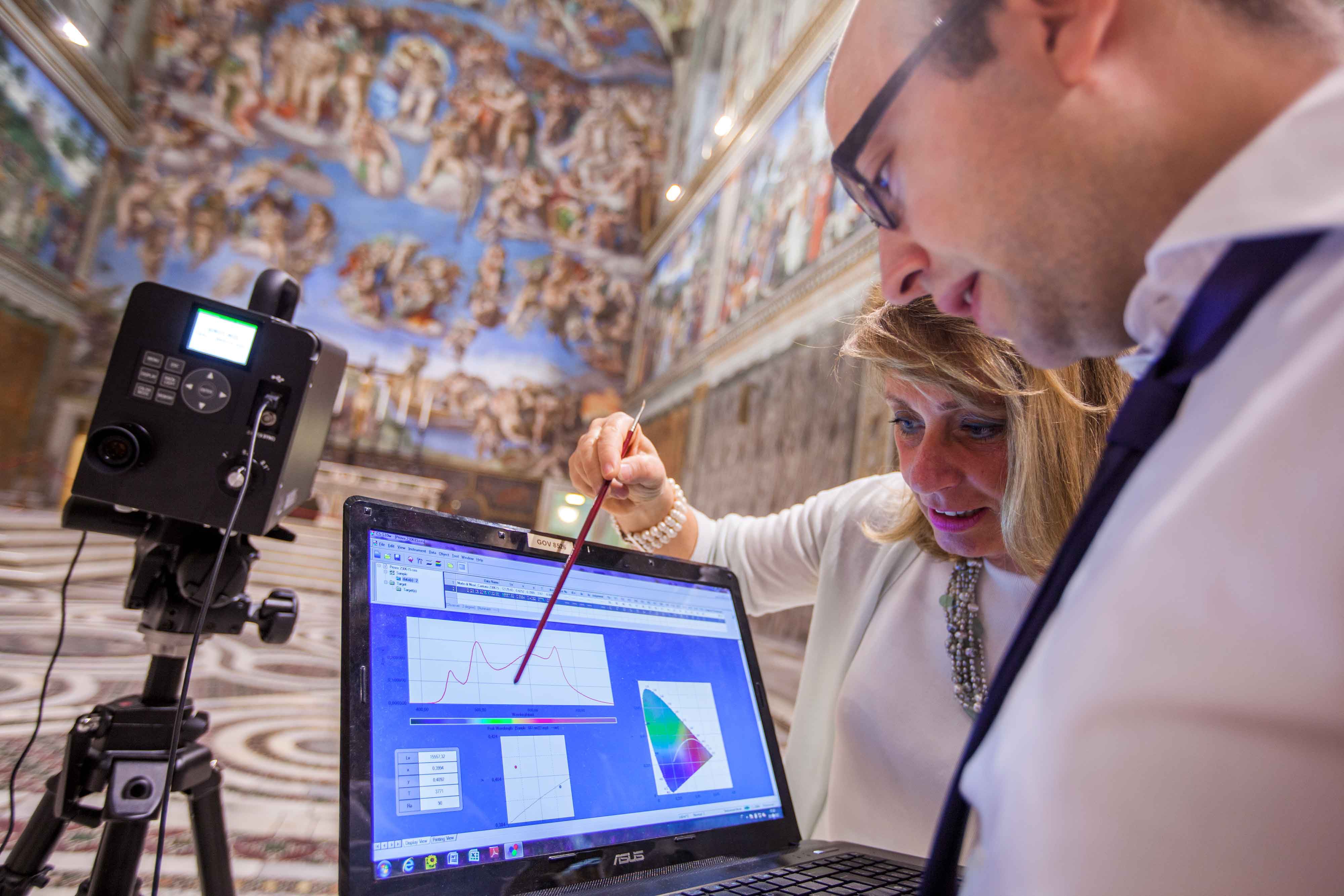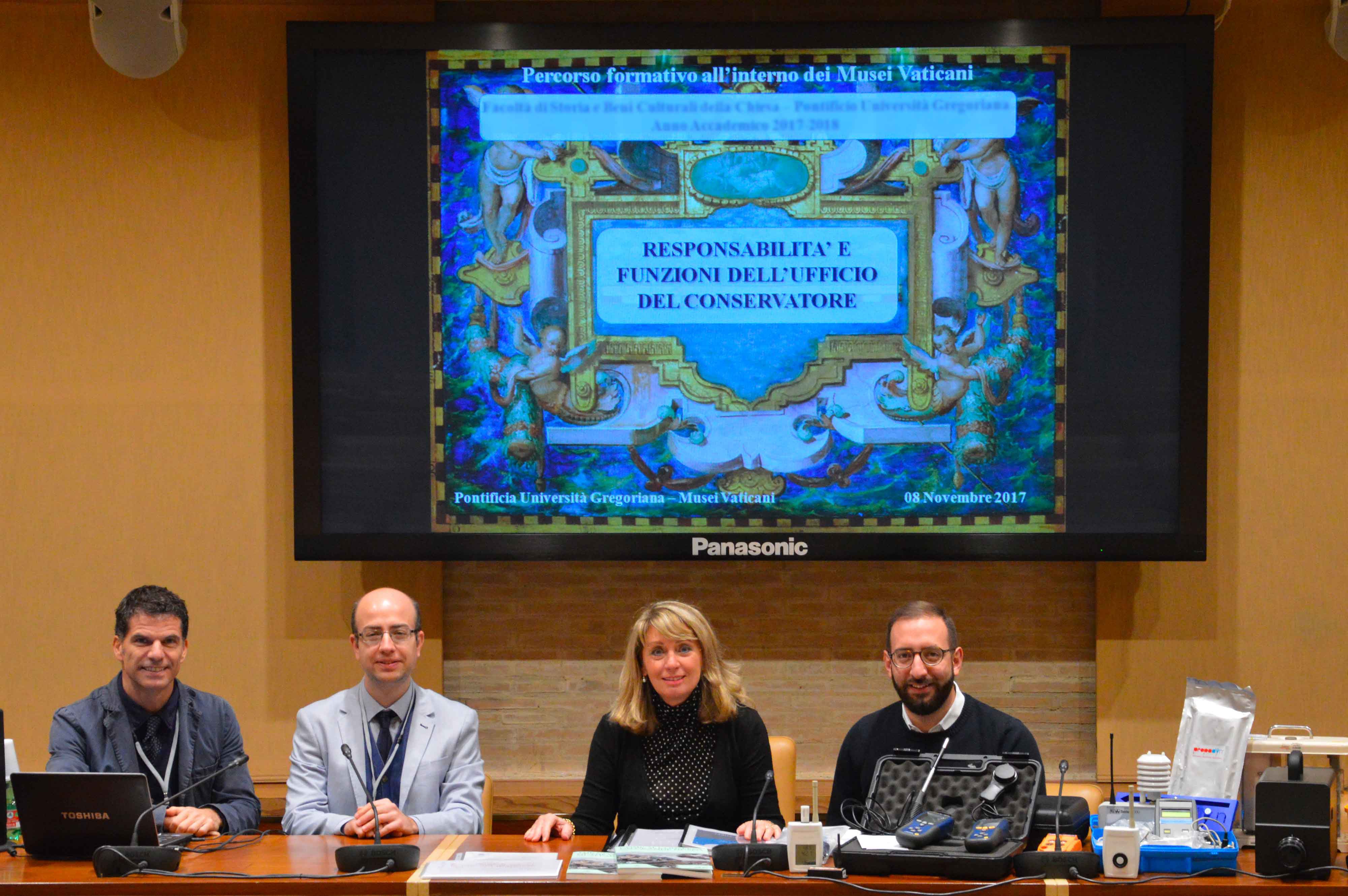Conservation of the Sistine Chapel
Classification: Conservation Project
Adopted By: The Washington D.C. Chapter
Total Cost: € 90,000
Description
Periodic Maintenance Plan of the Sistine Chapel
The Direction of the Vatican Museums instituted the Periodical Maintenance Plan of the Sistine Chapel in 2012 for the effective prevention of every possible future alteration on the frescoes after the discovery of subtle alterations on their surface. It consists of periodic checks of the painted plaster and the climatological values of the Sistine Chapel since, as is well known, the good health of the paintings is always correlated to the chemical-physical conditions of the environment that contains them.
The plan provides for the monitoring, periodic dusting, and documentation of the state of preservation of the surfaces. Specific supporting studies help track the preservation state of the paintings already subjected to the removal treatment. Since 2014, the year of the installment of the new air conditioning and lighting systems, there are regular inspections that take place to ensure operation and conservation compatibility. The Conservator’s Office, which oversees a monitoring or “control network” consisting of thirty or more sensors that record twenty-four hours a day, supports the control of the environmental conditions. They integrated a plan of activity for the environmental parameters of the chapel and the possible alterations produced by the presence of visitors at various times of the day.
The annual maintenance activity of the Sistine Chapel involves many laboratories, offices, and services of the Museums: in particular the Cabinet of Scientific Research, Painting Restoration Laboratory, Logistics Office, Maintenance Team, custodians, Conservation Office of the activity coordination, and the custodians of the Apostolic Palace. The study is carried out over five weeks, usually from January to mid-February. An aerial “spider” equipped with an articulated arm that reaches up to 20 meters in height allows conservers to quickly reach and inspect the frescoes that cover the walls and the vault, the terminals of the air conditioning and lighting systems, and the complex network of environmental sensors. Thus, the restorers of the Painting Restoration Laboratory, assisted by the scientific experts of the Scientific Research Laboratory, carry out a series of checks on the surfaces of the paintings, ascertaining their state of health and comparing recent and past records. The trained eye of the restorer is fundamental, but science also comes to the rescue of experience. Modern imaging techniques (such as the new HMI technology equipped with Scientific Research Laboratory) make it possible to evaluate even modest variations in paintings at a distance. These are “non-destructive” investigations of a physical nature that include the interaction between electromagnetic radiation and matter, without resorting to any collection of material.
The technicians of the Carrier company and those of DIIS, the Infrastructure, and Services Directorate of the Governorate, adjust the calibration system to humidify, dehumidify, heat, or cool the introduced air. They must repeat it every year. Osram’s lighting system is also subject to periodical checks.

Conservation of the Sistine Chapel

Details
Adopted by: The Washington D.C. Chapter
Patrons: Mrs. Monica Adorno
Classification: Conservation Project
Museum: Sistine Chapel
Wishbook year: 2021
Description
Periodic Maintenance Plan of the Sistine Chapel
The Direction of the Vatican Museums instituted the Periodical Maintenance Plan of the Sistine Chapel in 2012 for the effective prevention of every possible future alteration on the frescoes after the discovery of subtle alterations on their surface. It consists of periodic checks of the painted plaster and the climatological values of the Sistine Chapel since, as is well known, the good health of the paintings is always correlated to the chemical-physical conditions of the environment that contains them.
The plan provides for the monitoring, periodic dusting, and documentation of the state of preservation of the surfaces. Specific supporting studies help track the preservation state of the paintings already subjected to the removal treatment. Since 2014, the year of the installment of the new air conditioning and lighting systems, there are regular inspections that take place to ensure operation and conservation compatibility. The Conservator’s Office, which oversees a monitoring or “control network” consisting of thirty or more sensors that record twenty-four hours a day, supports the control of the environmental conditions. They integrated a plan of activity for the environmental parameters of the chapel and the possible alterations produced by the presence of visitors at various times of the day.
The annual maintenance activity of the Sistine Chapel involves many laboratories, offices, and services of the Museums: in particular the Cabinet of Scientific Research, Painting Restoration Laboratory, Logistics Office, Maintenance Team, custodians, Conservation Office of the activity coordination, and the custodians of the Apostolic Palace. The study is carried out over five weeks, usually from January to mid-February. An aerial “spider” equipped with an articulated arm that reaches up to 20 meters in height allows conservers to quickly reach and inspect the frescoes that cover the walls and the vault, the terminals of the air conditioning and lighting systems, and the complex network of environmental sensors. Thus, the restorers of the Painting Restoration Laboratory, assisted by the scientific experts of the Scientific Research Laboratory, carry out a series of checks on the surfaces of the paintings, ascertaining their state of health and comparing recent and past records. The trained eye of the restorer is fundamental, but science also comes to the rescue of experience. Modern imaging techniques (such as the new HMI technology equipped with Scientific Research Laboratory) make it possible to evaluate even modest variations in paintings at a distance. These are “non-destructive” investigations of a physical nature that include the interaction between electromagnetic radiation and matter, without resorting to any collection of material.
The technicians of the Carrier company and those of DIIS, the Infrastructure, and Services Directorate of the Governorate, adjust the calibration system to humidify, dehumidify, heat, or cool the introduced air. They must repeat it every year. Osram’s lighting system is also subject to periodical checks.
Media

Conservation of the Sistine Chapel

Conservator Office at work

Conservator Office

© 2025 Patrons of the Arts
in the Vatican Museums
Vatican Museums V-00120,
Vatican City State (Europe)
+39 0669864499
